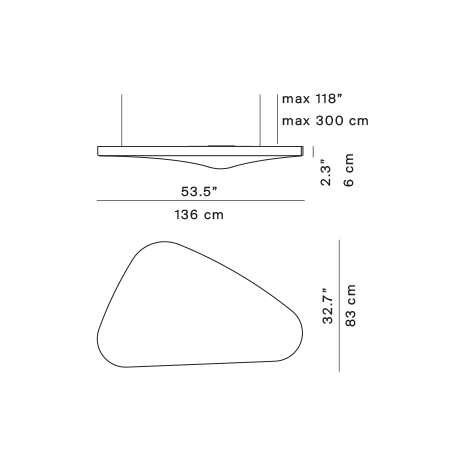PétaleSospensione
designed by Studio Odile Decq
Una lampada a sospensione dalla forma organica che cela dentro di sé la magia del silenzio: il corpo lampada, rivestito con un tessuto bianco, è costituito da un pannello fonoassorbente che consente di migliorare il comfort acustico all’interno dello spazio. Disponibile in tre dimensioni.
D71PV D71/7DV D71/7DVW D71/7DLW D71/7DL
Pétale petalo

D71PV D71/7DV D71/7DVW D71/7DLW D71/7DL
Pétale petalo
Specifiche principali
| Typology | Sospensione | ||
|---|---|---|---|
| Application | Interno | ||
| Material |
|
||
| Finishes |
|
||
| Dimensions (mm) | H 150, L 1360, W 830 | ||
| Weight (kg) | 5.44 | ||
| Light Source | LED 17W 3000k (strip module), for direct light: LED 45W (D71/7DV or D71/7DVW optic), 3000K, 2700K, CRI 90 |
D71P1V D71/7DV D71/7DVW D71/7DL D71/7DLW
Pétale trilobate

D71P1V D71/7DV D71/7DVW D71/7DL D71/7DLW
Pétale trilobate
Specifiche principali
| Typology | Sospensione | ||
|---|---|---|---|
| Application | Interno | ||
| Material |
|
||
| Finishes |
|
||
| Dimensions (mm) | H 150, L 1545, W 1200 | ||
| Weight (kg) | 8.5 | ||
| Light Source | LED 21W 3000K (strip module), for direct light: LED 45W (D71/7DV or D71/7DVW optic), 3000K, 2700K, CRI 90 |
D71CV D71/7DV D71/7DVW D71/7DL D71/7DLW
Pétale cerchio

D71CV D71/7DV D71/7DVW D71/7DL D71/7DLW
Pétale cerchio
Specifiche principali
| Typology | Sospensione | ||
|---|---|---|---|
| Application | Interno | ||
| Material |
|
||
| Finishes |
|
||
| Dimensions (mm) | H 150, D 1200 | ||
| Weight (kg) | 6.8 | ||
| Light Source | LED 18W 3000K (strip module), for direct light: LED 45W (D71/7DV or D71/7DVW optic), 3000K, 2700K, CRI 90 |
Acoustic and lighting benefits

Fornire un’illuminazione adeguata e allo stesso tempo una maggiore qualità acustica – una migliore qualità del parlato e una riduzione della propagazione del suono – permette di realizzare un ambiente confortevole, contribuendo al miglioramento del benessere e della produttività.
Dal 2012 Luceplan vanta una consolidata esperienza in soluzioni “all-in-one” che combinano alte prestazioni illuminotecniche, elevate prestazioni di fono-assorbenza e un design di alto livello per ogni ambiente.
Scopri la collezioneGet inspired

Se è ideale per l’impiego in composizioni di più “petali di luce” in grandi spazi per l’ospitalità e la socializzazione, Pétale svolge perfettamente le sue molteplici funzioni anche come “solista” in qualsiasi contesto abitato.
Offriamo le soluzioni per ogni spazio, sia per ambienti pubblici o privati. Scopri le nostre referenze e lasciati ispirare.
Get inspired













